Astronomers have discovered an asteroid in a companion orbit to the Earth. Named 2002 AA29, this 100 metre asteroid was discovered by the linear automated sky survey project in January. Although objects have been found to share the orbits of other planets, none have ever been found for the Earth. You don’t have to worry about it hitting the planet, though, as calculations of its orbit have determined that 2002 AA29 will never come closer than 4.5 million kilometres (12 times the distance from the Earth to the moon).
Atlantis Lands Safely at KSC
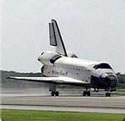
Image credit: NASA
Thanks in part to perfect weather, the space shuttle Atlantis touched down safely on Friday at the Kennedy Space Center. During their 11 days in space, the astronaut crew performed three spacewalks to successfully install the S1 truss to the International Space Station. The next mission to the ISS will be a Soyuz taxi flight, followed shortly by the space shuttle Endeavour; tentatively scheduled to launch November 10th.
Space Shuttle Atlantis glided to a noontime landing at the Kennedy Space Center in Florida completing a 4.5 million mile journey to outfit the International Space Station with a new section of truss and supplies for the Expedition crew onboard.
With weather of little concern today, Commander Jeff Ashby piloted the shuttle to its 60th landing at KSC at 10:44 a.m. CDT. The deorbit burn occurred an hour earlier as Atlantis flew high above the southwestern Indian Ocean, dropping the shuttle out of orbit for the high-speed reentry and landing.
Atlantis’ ground track carried it above Central America and western Cuba before crossing the west coast of Florida south of Tampa. Ashby took over manual control of Atlantis at an altitude of 50,000 feet, guiding the 200,000 pound shuttle through a 290-degree right turn to line up with Runway 33.
Meanwhile, aboard the International Space Station, the Expedition Five crew was able to watch Atlantis’ safe landing while the three crewmembers continue to unpack and stow supplies delivered by the shuttle crew. Commander Valery Korzun, NASA ISS Science Officer Peggy Whitson and Cosmonaut Sergei Treschev are in their 135th day in space (133rd aboard the station).
Their next visitors are the three members of a Soyuz Taxi Crew scheduled to deliver a fresh rescue spacecraft to the station later this month. Expedition Five’s ride home will be aboard Endeavour scheduled to launch no earlier than Nov. 10 bringing another truss segment and the Expedition Six crew.
Atlantis will be hauled into its hangar later today to begin preparations for its next mission to the station in March 2003 on the STS-114 mission.
Atlantis’ six crewmembers are expected to hold a news conference at about 4 p.m. today on NASA Television and plan to return to the Johnson Space Center in Houston Saturday at about 5:30 p.m. That time is subject to change.
The next ISS status report will be issued next Friday, Oct. 25, or as events warrant.
Original Source: NASA News Release
Rocket Explosion Kills Russian Soldier
A Russian soldier was killed on Tuesday by raining debris when a Soyuz-U rocket exploded 29 seconds after launch from the Plesetsk launch facility – eight other soldiers were also injured in the accident. The cause of the explosion is still unknown, but it’s unusual considering the reliability of the Soyuz vehicle. This launch failure could push back a schedule taxi mission on October 27 if the agency decides to inspect all Soyuz spacecraft.
Chandra Spots X-Ray Jet Evolution
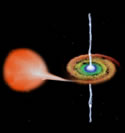
Image credit: Chandra
Astronomers announced this week that they have seen the complete life cycle of X-ray jets spewing out of a black hole. The jets were first discovered coming out of stellar mass black hole XTE J1550-564, and then the astronomers watched them for 4 years using the Rossi X-ray Timing Explorer. The jets were traveling at nearly the speed of light until this year when they began to slow down because of interactions with interstellar gas. Similar jets have been seen emanating from supermassive black holes, but they take thousands of years to go through this process.
For the first time, astronomers have tracked the life cycle of X-ray jets from a black hole. A series of images from NASA’s Chandra X-ray Observatory has revealed that as the jets evolved, they traveled at near light speed for several years before slowing down and fading.
“Watching these jets slow down and disappear is like watching a time-lapse movie of the rise and fall of the Bronze Age,” said Stephane Corbel of the University of Paris VII and the French Atomic Energy Commission in Saclay, lead author of a paper in the October 4th issue of the journal Science. “Since the jets came from a stellar black hole in our galaxy, we watched in a few years developments that would have taken thousands of years to occur around a supermassive black hole in a distant galaxy.”
Astronomers have been using Chandra and radio telescopes to observe two opposing jets of high-energy particles emitted following an outburst, first detected in 1998 by NASA’s Rossi X-ray Timing Explorer, from the double-star system XTE J1550-564. The X-ray jets, which require a continuous source of trillion-volt electrons to remain bright, were observed moving at about half the speed of light. Four years later, they are now more than three light years apart and slowing down. One of the jets has recently been observed to fade.
“The ejection of jets from stellar and supermassive black holes is a common occurrence in the universe, so it is extremely important to understand the process,” said John Tomsick of the University of California, San Diego, and author of an Astrophysical Journal paper scheduled for January 2003 publication describing the research. “For the first time, we have observed a jet from the initial explosion until it slowed and faded.”
The observations indicate that one jet, the eastern jet, is moving along a line tilted toward the Earth whereas the western jet is pointed away from the Earth. This alignment explains why the eastern jet appears to have traveled farther from the black hole than the western one. However, with this alignment, the eastern jet should be brighter than the western one, while the western jet was actually three times brighter.
“This poses a puzzle. The simple model for jets doesn’t explain what we are seeing,” said Philip Kaaret of the Harvard-Smithsonian Center for Astrophysics in Cambridge, Mass., and lead author of another upcoming Astrophysical Journal paper on XTE J1550-564. “Either the black hole may somehow be feeding more energy into the western jet, or that jet has run into a dense cloud.”
As jets plow through the interstellar gas, the resistance of the gas slows them down like air resistance slows down moving objects on Earth. Although all jets are believed to decelerate in this way, the observations of XTE J1550-564 mark the first time jets have been caught in the act of slowing down. The observed deceleration underscores the value of small, stellar black holes in our galaxy for studying similar processes that occur in distant quasars and active galactic nuclei.
XTE J1550-564, which is about 17,000 light years from Earth, was observed with Chandra’s Advanced CCD Imaging Spectrometer and the High Energy Transmission Grating instruments. Radio data used in this study were obtained by the Australia Telescope Compact Array.
NASA’s Marshall Space Flight Center in Huntsville, Ala., manages the Chandra program for the Office of Space Science, Washington, and TRW, Inc., Redondo Beach, Calif., is the prime contractor. The Smithsonian’s Chandra X-ray Center controls science and flight operations from Cambridge, Mass.
Original Source: Chandra News Release
Atlantis Launch Ends Long Shuttle Delays
The space shuttle Atlantis blasted off from the Kennedy Space Center today after four months of repairs and delays. The shuttle and its 6-astronaut crew lifted off at 1945 GMT (3:45pm EDT), and reached orbit shortly after; by Wednesday it will link up with the International Space Station. A new camera, mounted on the external fuel tank pointed down at the shuttle, and showed the whole launch until separation.
New Large Object Discovered Past Pluto
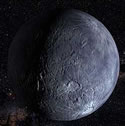
Image credit: Hubble
Astronomers have discovered a new object far past the orbit of Pluto. Dubbed Quaoar, the object is 1,200 km across (approximately 1/10th the size of the Earth), and orbits the sun once every 288 years. Although the object is half the size of the Pluto, it probably won’t be considered a new planet ? even Pluto’s planetness is hotly debated. Ironically, Quaoar was caught in images taken as far back as 20 years ago; astronomers just didn’t realize what they were looking at.
NASA’s Hubble Space Telescope has measured the largest object discovered in the solar system since the discovery of Pluto 72 years ago.
Approximately half the size of Pluto, the icy world 2002 LM60, dubbed “Quaoar” (pronounced kwa-whar) by its discoverers, is the farthest object in the solar system ever to be resolved by a telescope. It was initially detected by a ground-based telescope, as simply a dot of light, until astronomers aimed the powerful Hubble telescope at it.
Quaoar is about 4 billion miles away from Earth, well over a billion miles farther away than Pluto. Unlike Pluto, its orbit around the Sun is very circular, even more so than most of the planetary-class bodies in the solar system.
Although smaller than Pluto, Quaoar is greater in volume than all the asteroids combined (though probably only one-third the mass of the asteroid belt, because it’s icy rather than rocky). Quaoar’s composition is theorized to be largely ices mixed with rock, not unlike that of a comet, though 100 million times greater in volume.
This finding yields important new insights into the origin and dynamics of the planets, and the mysterious population of bodies dwelling in the solar system’s final frontier: the elusive, icy Kuiper belt beyond Neptune.
Michael Brown and Chadwick Trujillo of Caltech are reporting the findings today at the 34th annual meeting of the Division for Planetary Sciences of the American Astronomical Society in Birmingham, Ala.
Earlier this year, Trujillo and Brown used the Palomar Oschin Schmidt telescope to discover Quaoar as an 18.5-magnitude object creeping across the summer constellation Ophiuchus (it’s less than 1/10,000th the brightness of the faintest star seen by the human eye). Brown had to do follow-up observations using Hubble’s new Advanced Camera for Surveys on July 5 and August 1, 2002, to measure the object’s true angular size of 40 milliarcseconds, corresponding to a diameter of about 800 miles (1300 kilometers). Only Hubble has the sharpness needed to actually resolve the disk of the distant world, leading to the first-ever direct measurement of the true size of a Kuiper belt object (KBO).
Like Pluto, Quaoar dwells in the Kuiper belt, an icy debris field of comet-like bodies extending 7 billion miles beyond Neptune’s orbit. Over the past decade more than 500 icy worlds have been found in the Kuiper belt. With a few exceptions all have been significantly smaller than Pluto.
Previous record holders are a KBO called Varuna, and an object called 2002 AW197, each approximately 540 miles across (900 kilometers). Unlike Hubble’s direct observations, these diameters are deduced from measuring the objects’ temperatures and calculating a size based on assumptions about the KBOs’ reflectivity, so the uncertainty in true size is much greater.
This latest large KBO is too new to have been officially named by the International Astronomical Union. Trujillo and Brown have proposed naming it after a creation god of the Tongva native American tribe, the original inhabitants of the Los Angeles basin. According to legend, Quaoar, “came down from heaven; and, after reducing chaos to order, laid out the world on the back of seven giants. He then created the lower animals, and then mankind.”
Quaoar’s “icy dwarf” cousin, Pluto, was discovered in 1930 in the course of a 15-year search for trans-Neptunian planets. It wasn’t realized until much later that Pluto actually was the largest of the known Kuiper belt objects. The Kuiper belt wasn’t theorized until 1950, after comet orbits provided telltale evidence of a vast nesting ground for comets just beyond Neptune. The first recognized Kuiper belt objects were not discovered until the early 1990s. This new object is by far the “biggest fish” astronomers have snagged in KBO surveys. Brown predicts that within a few years even larger KBOs will be found, and Hubble will be invaluable for follow-up observations to pin down sizes.
Original Source: Hubble News Release
What is the biggest telescope in the world?
Best Infrared Image Ever Taken of our Galaxy’s Heart
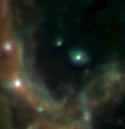
Image credit: NASA
A team of astronomers have taken the highest resolution mid-infrared picture ever taken of the center of our Milky Way galaxy. The image is so detailed, you can actually see dust swirling around the giant black hole located at the centre of the galaxy. The camera, called the Mid-Infrared Large-Well Imager, or Mirlin, is attached to the enormous Keck observatory in Hawaii.
The highest resolution mid-infrared picture ever taken of the center of our Milky Way galaxy reveals details about dust swirling into the black hole that dominates the region.
The image was taken by a team led by Dr. Mark Morris of the University of California, Los Angeles, at the Keck II telescope in Hawaii, with an infrared camera built at NASA’s Jet Propulsion Laboratory, Pasadena, Calif. The camera, called the Mid-Infrared Large-Well Imager, or Mirlin, used three different infrared wavelengths to build the color composite image available online at http://irastro.jpl.nasa.gov/GalCen/galcen.html.
The mid-infrared part of the electromagnetic spectrum comprises the wavelengths at which room temperature objects glow most brightly. Everything on Earth, including the telescope, the astronomers, and even the atmosphere, emits a bright glow in the mid-infrared. Seeing celestial objects though this glow is like trying to see stars during daylight; special techniques are needed to tease the stars from this glow to build a recognizable picture.
Near the center of the image, but not apparent at these wavelengths, is a black hole three million times heavier than our Sun. Its gravitational pull, so powerful that not even light can escape from its surface, affects the motion of dust, gas and even stars, throughout the region.
A veil of dust absorbs the visible light emitted by most of the stars near the Galactic Center. The light warms the dust, which then radiates in the infrared and becomes visible to the mid-infrared camera.
The image shows this dusty material spiraling toward the black hole, most notably the stream of gas and dust called the Northern Arm. When this material eventually falls into the black hole, it will release energy that affects everything in its vicinity. This event, which astronomers are certain has happened many times in the history of the Milky Way, may trigger the formation of a new generation of stars by causing other nearby dust clouds to collapse, or it may actually inhibit the formation of new stars if the released energy destroys those clouds. Either way, the black hole continues to grow larger as new material falls into it.
Astronomers know that the stars in this image are all very luminous, because less luminous stars appear very faint to a mid-infrared camera. A massive star nearing the last stages of its life, the red supergiant IRS7, is visible in this image as the smallish, bright spot just above the center. IRS7 is simply so luminous — more than 100,000 times as bright as our Sun — that we can see its starlight directly.
The “mini-cavity” in the center is a bubble that has apparently been evacuated of dust and gas. A star located at the center of the mini-cavity (not visible in this image) apparently blows this bubble with its powerful stellar wind. The “bullet” is a mysterious, fast-moving feature pointing roughly away from the mini-cavity, just below and to the right of the center. It may be a jet composed of gas and dust.
Other members of the Mirlin imaging team, along with Morris, are Dr. Andrea Ghez, Dr. Eric Becklin and Angelle Tanner of UCLA; Drs. Michael Ressler and Michael Werner of JPL; and Dr. Angela Cotera Hulet of the Arizona State University, Tempe, Ariz. The camera was built at JPL by Ressler and Werner. Operation of Mirlin is supported by a grant from NASA’s Office of Space Science, Washington, D.C. Some findings based on this image have been published in the Astrophysical Journal.
Studying processes in the center of our own galaxy may teach astronomers more about much more active, more distant galactic nuclei — objects like quasars and Seyfert galaxies, which are the most violent places known in the universe. More information about both the center of our Milky Way and the centers of other galaxies may be obtained with future instruments that have higher resolution and greater sensitivity.
For example, NASA is planning a similar infrared camera, the Mid-Infrared Instrument, one of three instruments that will fly aboard the James Webb Space Telescope, launching in 2010. This camera will achieve resolution roughly equivalent to the Keck images, but because it will orbit above the warm glow emitted by Earth’s atmosphere, it will be 1,000 times more sensitive. Using this instrument, astronomers will be able to study the centers of galaxies all the way to the edge of the observable universe.
JPL, in conjunction with a consortium of European countries and the European Space Agency, is developing the Mid-Infrared Instrument. The James Webb Space Telescope is managed by the Goddard Space Flight Center, Greenbelt, Md.
JPL is a division of the California Institute of Technology in Pasadena.
Original Source: NASA/JPL News Release
Atlantis Launch Pushed Back to Monday
Because of Hurricane Lili bearing down on the Gulf Coast of the US, NASA flight controllers decided to delay the launch of the space shuttle Atlantis until Monday. At agency headquarters in Houston, the agency began precautions to shut down computers and evacuate the area if the weather conditions worsen ? they also transferred control of the International Space Station to Moscow. Ironically, the weather at the launch pad in Florida was perfectly clear.
Progress Docks with International Space Station
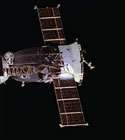
Image credit: NASA
After four days in space, a Russian Progress M1-9 docked with the International Space Station on Sunday afternoon at 1701 GMT (1:01pm EDT). The unmanned cargo vessel carries 2.6 tons of food, fuel and equipment for the station. The operation took a little longer than normal because Russian controllers used the opportunity to test the Kurs automated docking system employed on the Zvezda module.
An unmanned Russian resupply craft successfully docked to the International Space Station Sunday, bringing almost a ton of food, fuel and supplies to the residents on board, and for the next trio of space travelers, which will arrive on the ISS in November.
The Progress 9 vehicle linked up to the aft docking port of the Zvezda Service Module of the ISS at 12:01 p.m. Central time (1701 GMT) as the two spacecraft flew over Central Asia after a four-day flight following its launch Wednesday from the Baikonur Cosmodrome in Kazakhstan. The automated docking went off without a hitch as Expedition 5 Commander Valery Korzun, NASA ISS Science Officer Peggy Whitson, and Flight Engineer Sergei Treschev viewed the arrival of the new capsule from inside Zvezda. A few minutes later, hooks and latches closed between the two vehicles to form an airtight seal.
Korzun was prepared to take over manual control of the Progress for the docking in the event its automated rendezvous system did not work, but the linkup was executed flawlessly.
The crew was scheduled to open hatches between Zvezda and Progress this afternoon and will begin unloading supplies from the craft on Monday.
Some of the supplies include clothing and personal items for the Expedition Six crew ? Commander Ken Bowersox and Flight Engineers Nikolai Budarin and Don Pettit ? who will be launched aboard Endeavour on the STS-113 mission in November to replace Korzun, Whitson and Treschev following the completion of their 5 ? month mission.
The older Progress 8 vehicle, which arrived at the ISS in June and which was undocked on Tuesday, remains in orbit a safe distance away from the station, spending another 10 days aloft to enable Russian flight controllers to document smog and smoke over northeastern Russia through its cameras.
The Progress docking clears the way for the launch of Atlantis on the STS-112 mission Wednesday to deliver the 14-ton Starboard 1 (S1) Truss to the station. A Wednesday launch would result in Atlantis? docking to the ISS Friday. Commander Jeff Ashby, Pilot Pam Melroy and Mission Specialists Dave Wolf, Sandy Magnus, Piers Sellers and Fyodor Yurchikhin are in the final stages of their prelaunch preparations.
Original Source: NASA News Release
New Camera Will Give a Bird’s Eye View of Shuttle Launch
NASA is now offering the most innovative new point of view to television viewers since the Astronaut-Cam. They’ve attached a camera onto the top of the space shuttle Atlantis’ external fuel tank. The camera points down at the shuttle orbiter’s front and belly as well as one of the solid booster rockets. The feed from the camera will be broadcast on NASA television during the launch.
